What's Happening Here?
It’s back by popular demand. That’s right, many subscribers have told me this is their favorite segment of the newsletter. Before I get to this week’s diagnostic challenge, I’d like to thank you for reading Perennial Pulse. I really appreciate your feedback. Continue to let me know what you like and what you don’t like and I’ll continue evolve the newsletter to remain relevant to you and your business. Send any questions, comments and content ideas my way at ppilon@ballpublishing.com.
Now on to the challenge. Here’s an image of Coreopsis Jethro Tull I recently came across at one of the few greenhouses I’ve visited this spring.
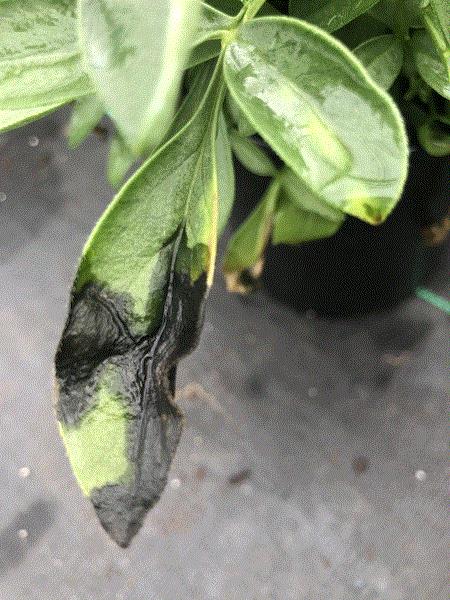
I think you’d agree that this is not normal and something is definitely going on here. The spots were mostly present in the middle and lower portions of the plant (generally not on the newest growth).
Keep in mind that the leaves are wet which is contributing to the dark and perhaps even oily appearance. You can see the water on the adjacent leaves. Am I telling you this as a clue or to throw you off the diagnostic path? You’ll have to wait to find out. Take your time, enjoy the newsletter and I’ll reveal the answer before signing off. It’s time for me to ask, “What’s Happening Here?”

Offshore Greenhouse Certification Program
The USDA’s Animal and Plant Health Inspection Service (APHIS) has an open invitation to greenhouses located outside the United States to participate in its newly established Offshore Greenhouse Certification Program (OGCP).
In short, greenhouses in the program will agree to produce admissible unrooted cuttings under a systems approach to reduce pest and disease risks. In return, shipments exported under this program will be subject to receive fewer or less frequent inspections at U.S. plant inspection stations, helping to expedite clearance and entry into the country.
I asked John Gaydos of Proven Winners North America, who was on the pilot program committee, his thoughts on the importance of this new program. Here's his response:
“The tremendous work and collaboration of the USDA-APHIS and members of the industry has produced the Offshore Greenhouse Certification Program that will streamline the flow of certified clean unrooted cuttings into the United States. The real value of this program lies in the reduction of time between harvest and stick. Through open discussion and an evaluation of risk, a certification program of stock production facilities was established that is applicable for operations around the world. APHIS inspection agents will be able to reduce the amount of time that incoming vegetative products spend at the ports of entry and therefore decreasing the degradation of the cuttings and increasing the success rate of rooting. Those of us on the pilot program committee are extremely pleased to have had the opportunity to work with the guidance of AmericanHort and APHIS to change the industry.”
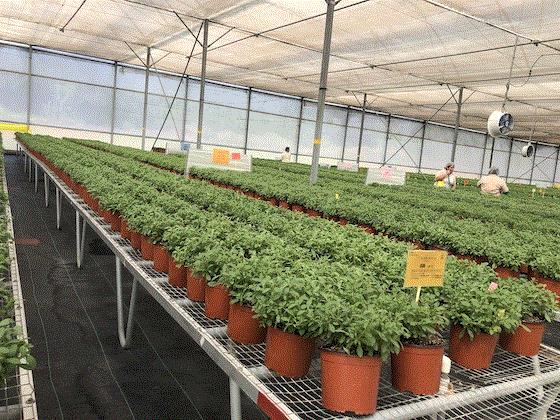
Stock plant production at Ticoplant in Costa Rica. Ticoplant and Innova Plant are two stock plant facilities producing cuttings for Proven Winners in Costa Rica. They are both certified in the OGCP.
To participate in the OGCP, interested facilities must be visited and certified by APHIS officials and meet the program's minimum standards for greenhouse construction, security, production, sanitation, pest management, training and recordkeeping. These standards are described in the Offshore Greenhouse Certification Program Framework.
If you export unrooted cuttings to the United States and are looking for methods of reducing the time from harvest to your customers receiving the cuttings, the OGCP can help you move in this direction. The program is just in time for this upcoming 2020-2021 season. Contact Karelyn Cruz - Offshore Certification Specialist (karelyn.cruz@usda.gov) before August 31, 2020 to learn more details on the Offshore Greenhouse Certification Program.

New Perennials from PP&L
Each year, Pacific Plug and Liner (PP&L) puts on a heck of a show during the California Spring Trials. Unfortunately it didn’t happen this year, but I wanted to share a few new perennials that would’ve been on display.
Carex Feather Falls
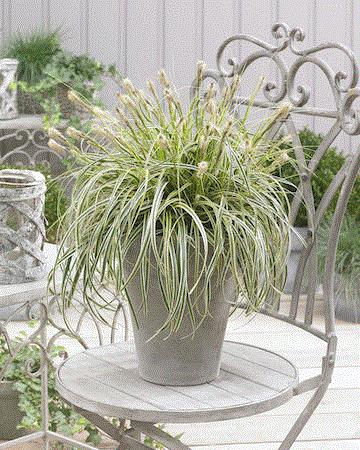
Feather Falls isn’t a new introduction, but is well worth mentioning here. This is an impressive, vigorous and supersized variegated carex. Besides its nice, fine textured appearance, Feather Falls is one tough plant. It holds up well in the landscape and tolerates extreme conditions including heat and cold. It grows 12 to 18 inches tall and is hardy to Zone 5.
Delphinium Delgenius Series
|
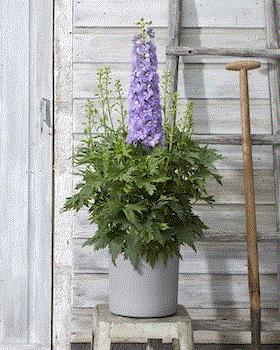
Delgenius Shelby
|
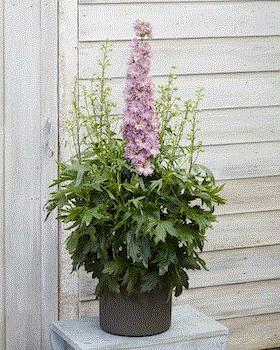
Delgenius Juliette
|
The Delgenius series of delphinium is bred by hellebore and echibeckia breeder Bart Noordhuis. This series is selected for growers to succeed. It’s well-branched and grows quickly, resulting in full pots with multiple flowers. The plants are compact for a delphinium. The sturdy flower spikes grow 18 to 24 inches tall and aren’t prone to falling over. There are three cultivars in the series, Breezin, Juliet (above left) and Shelby (above right), each producing multiple semi-double blooms. Hardy to Zone 3 and bred to tolerate heat as well.
Two New Echibeckias
If you haven’t seen them before, I’m certain you’ll be impressed with the flower power they provide. Like the name implies, echibeckia is a true cross between rudbeckia and echinacea. As a result, echibeckia grows fast, is resistant to diseases and produces tons of colorful, long lasting flowers. How long do they last? Each flower can last up to 10 weeks. Northerners beware, you might fall in love with echibeckias, but they are only hardy to Zone 7. However, we can definitely enjoy them as colorful annuals.
|

Summerina Sunchaser
|
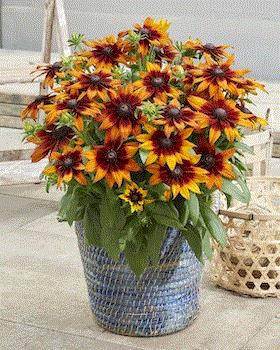
Summerina Sunreef
|
Sunchaser and Sunreef are the newest additions to the popular Summerina series. Sunchaser produces large flowers with summery yellow and orange tones. The flowers are nearly 8 inches across. Sunreef has large six-inch two-toned orange and red flowers. They both have large habits, growing approximately 20 to 24 inches tall. These introductions are easy to grow and have lots of flower power.

PPA Goes Virtual
First, I have an important announcement to share. In light of current events, the Perennial Plant Association (PPA) has postponed the 2020 Perennial Symposium which was going to be held in Lancaster, Pennsylvania, this summer until July 26-30, 2021. Spoiler alert, the 2022 Perennials Symposium is going to be held in Niagara Falls, Ontario. Stay tuned or visit www.perennialplant.org for details on these events as they become available.
PPA: Virtual Edition: New Ways to Communicate
The PPA also recently announced it will be holding its first virtual event called PPA: Virtual Edition, on June 17, 2020. The fast-paced premier webinar titled "New Ways to Communicate" is presented in partnership with GardenComm, and features five dynamic experts who each will share great communication and marketing ideas in the quick, 15-minute sessions. The speakers are:

-
Jessica DeGraaf, Proven Winners
-
C.L. Fornari, The Garden Lady
-
Jennifer Polanz, Green Profit & Inside Grower
-
Jo Ellen Meyers Sharp, Write for You! & GardenComm President
-
David Wilson, Overdevest Nurseries
It all begins at 3:00 p.m. EST on June 17 and includes a private garden tour and a happy hour (limited tickets available). Click here for event info and registration.
PPA Virtual Edition: Best of the Best Perennials
On June 24, 2020, the PPA will be hosting their second virtual event. In this webinar, five perennial experts will choose their favorite Perennial Plant of the Year (PPOY) winners. They’ll talk about what features they like and how they use and maintain these great perennials. The speakers are:

-
Steve Aitken, Fine Gardening
-
Richard Hawke, Chicago Botanic Garden
-
Holly Scoggins, AmericanHort
-
Paul Westervelt, Saunders Brothers, Inc.
-
Allyson Hoffmeyer, Hoffie Nursery, Inc.
Attendees will be taken on a virtual tour of the PPOY display garden at Hoffie Nursery. There will also be a Happy Hour for a limited number of people immediately following the presentations and tour.
This virtual event starts at 3:00 p.m. EST on June 24. Click here for event details.

Darwin Digital Days
While on the subject of virtual events, I’d like to remind you of next week's Darwin Digital Days. It’s being held Monday, June 15 through Friday, June 19, 2020. The event will consist of virtual tours of their Zone 5 perennial gardens, educational opportunities with key perennial suppliers, interactive keynote speakers and the ability to learn about the newest perennial genetics in the industry.
Learn how to use temperature, fertilizers and PGRs to hold plants during unusual springs like the one we had this year in my upcoming webinar during Darwin Digital Days.
Join me on Wednesday, June 17, 2020 as I present a webinar titled, “How to Hold ‘em and Diagnose Perennial Crop Problems” at 2 p.m. CST. In this presentation, I’ll be discussing how to hold plants and maintain plant quality during late springs and cover many cultural issues I’ve come across over the years (sort of a live “What’s Happening Here?").
Dr. Garrett Owen from the University of Kentucky is also presenting on Wednesday. He’ll be sharing the latest research on perennial propagation including supplemental lighting and rooting compounds.
Visit https://www.darwinperennials.com/digitaldays/to learn about this multiday event.

The Answer Is …
At the top of the newsletter I showed this image and asked if you could identify what’s happening with this coreopsis.
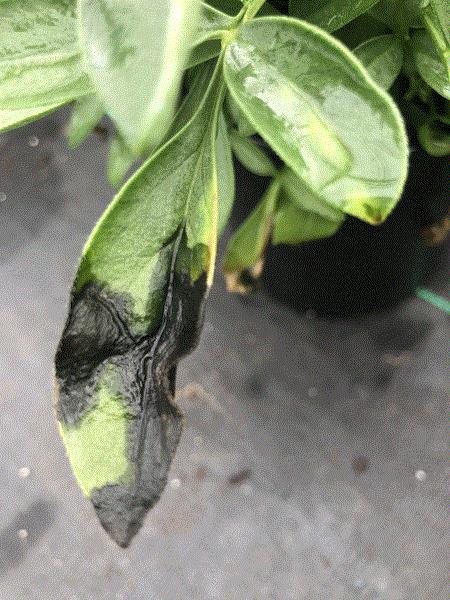
Before I tell you what I think is going on, take a look at the image below for a different perspective.

To be completely honest here, the same symptoms were observed on two differently aged crops of coreopsis being grown in two different greenhouses at the same growing facility. The top image is from a slightly younger planting and the second image is from a more mature crop.
Are you ready to learn the answer? Alright then, here it is. I didn’t get this diagnosed, but the symptoms are typical of bacterial leaf spots caused by Pseudomonas cichorii. I wouldn’t necessarily call it a commonly recurring issue, but I have seen it a number of times on coreopsis over the years.
As you likely already know, wet leaves are great for promoting bacterial issues. Therefore, to prevent the spread of bacterial leaf spots, it’s important to minimize wet leaves and splashing water from plant to plant. I know this is easier said than done, right?
Bactericides are best applied preventatively or upon very early detection. I like to rotate between copper-based fungicides such as Phyton 27, Kocide 3000, Kalmor or Camelot O and the disinfectant/fungicide/bactericide KleenGrow. Biofungicides containing various strains of Bacillus, such as Cease, Stargus, Triathlon BA and Double Nickel have also been shown to provide good control of bacterial leaf spots when they are applied preventatively.




One last thought. Don’t forget that June is Perennial Garden Month. Let’s continue the spring momentum and let consumers know that June is a great time to garden with perennials.
Thanks for reading this edition of Perennial Pulse. My email is ppilon@ballpublishing.com if you have any comments or suggestions.
Take care,
Paul Pilon
Editor-at-Large
Perennial Pulse
This email was received by you and 30,603 other fine subscribers!
If you're interested in advertising in Perennial Pulse, contact Kim Brown ASAP and she'll hook you up.